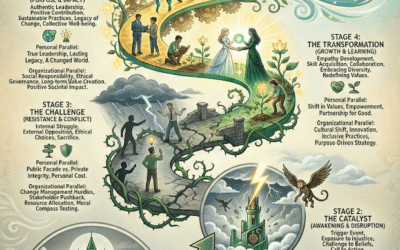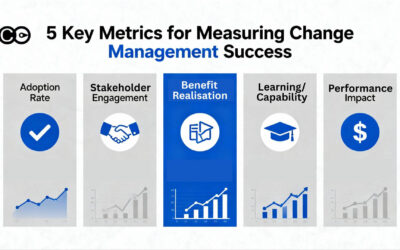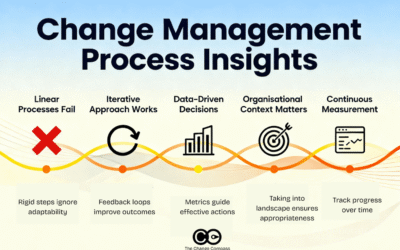Change readiness is one of the most critical, yet often misunderstood, concepts in organizational change management. For many practitioners, it’s been reduced to a series of surveys or assessments — a simple gauge of how “ready” stakeholders feel. But this oversimplification often leads to missed risks, unforeseen barriers, and ultimately, failed initiatives.
What is a change readiness assessment and why is it important?
A change readiness assessment evaluates an organization’s preparedness for implementing changes, including aspects of organizational culture. It identifies potential obstacles, gauges employee attitudes, and measures overall alignment with new initiatives. This assessment is crucial as it helps leaders strategize effectively, ensuring smoother transitions and higher acceptance rates among employees during the change process.
True readiness requires more than checking a box on perceptions; it’s about strategically evaluating whether the organisation, at every level, is equipped to embrace, execute, and sustain the change. Let’s explore what it takes to reimagine change readiness as a multi-dimensional, evidence-based approach that ties people, processes, and technology into a cohesive readiness framework.
The Myth of the Readiness Survey
Surveys are not inherently bad tools, but they have their limits. Let’s start by looking at why they’ve become synonymous with readiness assessments and the pitfalls they often present.
Why Surveys Dominate
Surveys are appealing because they are quick, scalable, and easy to analyse. A single survey can provide insights into stakeholder sentiment across a large audience, giving change managers a sense of where resistance might lie.
The problem is that surveys capture perceptions, not reality. Stakeholders might report high awareness of a change but lack the detailed understanding required to implement it effectively. Most survey ask if a stakeholder is aware of certain aspects about the project. However, it doesn’t go into the depth in which the level of awareness is what is expected at that phase of the project (to do this a ‘test’ may be required). Similarly, they might feel optimistic about a change initiative but underestimate the challenges involved.
Example of Survey Pitfalls
Consider a large retail chain rolling out a new inventory management system. A readiness survey revealed that 85% of employees were aware of the change, and 75% felt confident they could adapt. However, post-implementation data told a different story:
- Less than 50% of employees were actually using the new system correctly.
- Misaligned processes between stores caused delays in inventory updates.
- Leadership was disengaged, leading to inconsistent enforcement of new practices.
This misalignment occurred because the survey captured what employees thought, not what they could actually do. This just shows knowing may not equate to doing. Being aware, and understanding something does not necessarily translate into behaviour change.
Change readiness is not a one-dimensional measure of sentiment or awareness; it is the alignment of key elements—people, processes, technology, and leadership—toward the successful delivery of a change initiative.
Depending on the initiative the dimensions may also be different since different initiatives may require more or less of the various elements to be successful. For example, if there is a strong behavioural compliance element to the change, then tracking the change readiness process from understanding the why, strong leadership reinforcement, and operational reporting process setup may all critical elements of readiness.
Key Dimensions of Readiness
- Leadership ReadinessAre leaders aligned on the vision and goals of the change? Are there different levels of readiness of different leadership levels?
- Do they have the skills to lead their teams through uncertainty? What parts of the leadership skills are lacking? Coaching? Communication?
- Are they modelling the behaviours required for change adoption?
- Employee Capacity and CapabilityDo employees have the skills to adopt new processes or tools?
- Can the organisation absorb the change given competing priorities and the context of change efforts? What does the change landscape look like? What about the operational capacity constraints?
- Process ReadinessAre operational processes aligned with the new ways of working? Are new processes required being worked on so that the change may be sustained as business-as-usual after Go-Live? Are accountabilities clear for the new or changed processes?
- Are dependencies between departments or systems resolved?
- Technological ReadinessAre systems and tools tested and reliable?
- Are integrations with existing technology functioning as expected?
- Sponsorship and GovernanceAre sponsors actively engaged, providing oversight, and removing roadblocks? Or does the sponsor delegate all tasks and not really visible?
- Is there a governance structure to monitor progress and address risks? For example, if risks need to be addressed would that decision be made or would the project just continue along?
- Cultural/Behavioural ReadinessIs the organisational culture supportive of innovation and adaptability? In a lot of cases the organisation may not be ready, but the assessment needs to be on to what the extent the departments impacted have the capacity to change and adapt. This of course also depends on the quantum of the change.
- Are there underlying resistance patterns that need addressing? If so, are they valid feedback regarding how previous changes were planned and executed, or is the negative behaviour inherent in the culture?
- Are leaders aligned on the vision and goals of the change? Are there different levels of readiness of different leadership levels?
- Do they have the skills to lead their teams through uncertainty? What parts of the leadership skills are lacking? Coaching? Communication?
- Are they modelling the behaviours required for change adoption?
- Do employees have the skills to adopt new processes or tools?
- Can the organisation absorb the change given competing priorities? What does the change landscape look like? What about the operational capacity constraints?
- Are operational processes aligned with the new ways of working? Are new processes required being worked on so that the change may be sustained as business-as-usual after Go-Live? Are accountabilities clear for the new or changed processes?
- Are dependencies between departments or systems resolved?
- Are systems and tools tested and reliable?
- Are integrations with existing technology functioning as expected?
- Are sponsors actively engaged, providing oversight, and removing roadblocks? Or does the sponsor delegate all tasks and not really visible?
- Is there a governance structure to monitor progress and address risks? For example, if risks need to be addressed would that decision be made or would the project just continue along?
- Is the organisational culture supportive of innovation and adaptability? In a lot of cases the organisation may not be ready, but the assessment needs to be on to what the extent the departments impacted have the capacity to change and adapt. This of course also depends on the quantum of the change.
- Are there underlying resistance patterns that need addressing? If so, are they valid feedback regarding how previous changes were planned and executed, or is the negative behaviour inherent in the culture?
Example of a Strategic Approach
A financial services firm implementing a new risk management framework took a holistic approach to readiness. Instead of relying solely on stakeholder feedback, they:
- Conducted leadership alignment workshops to ensure consistency in messaging.
- Assessed employee capacity through workload analysis, adjusting timelines to reduce burnout risk. Given the significant focus on risk with multiple initiative items all targeting risk, managing capacity and prioritisation is important.
- Simulated new risk-reporting processes to identify and address bottlenecks.
- Used tools to analyse training completion rates and correlate them with system usage data.
This approach ensured readiness across all dimensions, reducing post-implementation issues.
Who Determines Readiness? Not Just Stakeholders
Stakeholders play an important role in assessing readiness, but they are not the sole authority. Their feedback is valuable, but it must be balanced with input from project teams, leadership, and objective data sources.
You can take the doctor-patient analogy here. The patient may tell you they are feeling well, however the trained physician may see symptoms that things may not be what they seem. Of course, the patient will need to understand why things may not be as they appear and want the treatment for it to go ahead. However, the physician has the accountability to form a diagnosis and subscribe the treatment. A trained change practitioner is no different and needs to cast a lens taking into account a range of evidence to form an assessment.
Mapping the Required vs. Observed Levels of Readiness
To truly determine readiness, it’s essential to compare the required level of readiness at each phase of a project with the observed level.
- Define Required ReadinessWhat specific outcomes must be achieved at this stage? E.g. Awareness level, discussions and briefings about the change at impacted business units, town hall sessions, coaching sessions, etc.
- What capabilities, processes, and systems need to be in place?
- Assess Observed ReadinessUse surveys, interviews, and observations to gather qualitative data.
- Analyse quantitative data from project reports, metrics, and tools.
- Identify Gaps and RisksWhere do observed levels fall short of required levels?
- What are the risks of proceeding with these gaps?
- Develop a Mitigation PlanCollaborate with stakeholders to address critical gaps.
- Adjust timelines, allocate resources, gain more leadership presence or provide additional training, refreshers as needed.
- What specific outcomes must be achieved at this stage? E.g. Awareness level, discussions and briefings about the change at impacted business units, town hall sessions, coaching sessions, etc.
- What capabilities, processes, and systems need to be in place?
- Use surveys, interviews, and observations to gather qualitative data.
- Analyse quantitative data from project reports, metrics, and tools.
- Where do observed levels fall short of required levels?
- What are the risks of proceeding with these gaps?
- Collaborate with stakeholders to address critical gaps.
- Adjust timelines, allocate resources, gain more leadership presence or provide additional training, refreshers as needed.
Example
In a healthcare organisation transitioning to electronic medical records (EMR), required readiness included:
- Leadership capable of driving adoption across departments.
- Staff proficient in using the new system.
- IT support ready to address technical issues.
Observed readiness showed gaps in staff proficiency and IT capacity. The organisation postponed the rollout to provide targeted training and hire additional contract IT staff, avoiding potential disruptions to patient care.
What to Do With Readiness Outcomes
A readiness assessment is only as valuable as the actions it informs. Once gaps are identified, they must drive decisions and interventions to keep the initiative on track.
Turning Insights Into Action
- Engage Stakeholders in Decision-Making
- Share readiness findings with key stakeholders, including project teams, sponsors, and impacted groups. Align on priorities for closing gaps.
- Tailor Interventions to Critical Needs
- Focus efforts on the most significant gaps that could derail the initiative. This is a key point since there may be a long list of desirable elements that should be there but are not. Most projects have limited time and resources so you should always focus on the most critical gaps that need addressing.
- Monitor Progress Continuously
- Readiness is not static. Reassess periodically to ensure interventions are effective. In this way you can also track the ongoing shifts in readiness, hopefully demonstrating that the readiness is increasing closer to the Go-Live.
A manufacturing company preparing to launch a new product line used readiness outcomes to guide their actions:
- Leadership Readiness Gap: Conducted intensive coaching sessions with plant managers to align messaging and prepare for likely employee questions and responses.
- Process Gap: Piloted the production process in a single plant to refine workflows prior to broader roll out.
- Technological Gap: Added two weeks to testing cycles to address system bugs.
These targeted interventions ensured a smoother launch with minimal disruption.
Evidence-Based Readiness: A Balanced Approach
Stakeholder perceptions are important, but they must be balanced with objective evidence. An evidence-based approach combines multiple data sources to provide a more accurate and actionable view of readiness. Prior to Covid, it would be typical to ‘walk the floor’ to get a sense what is happening and actual sentiments on the floor for employees. With a virtual workforce, there are digital means to gage engagement and sentiments.
Key Sources of Evidence
- Surveys and InterviewsCapture stakeholder sentiments, concerns, and insights.
- Use open-ended questions to uncover nuanced perspectives.
- ObservationMonitor real-world behaviours, such as system usage or meeting participation.
- Identify gaps between what people say and what they do.
- Metrics and ReportsAnalyse training completion rates, system performance, and project milestones. Other metrics may also include operational indicators and reporting.
- Leverage digital tools to uncover trends and correlations.
- Digital ToolsLeverage corporate social channels such as Yammer to gain overall understanding of potential sentiments and engagement levels.
- Project website pages may also be created, with viewership tracked to assess if viewership levels are as anticipated
- Use digital survey tools to manage and analyse data
- Capture stakeholder sentiments, concerns, and insights.
- Use open-ended questions to uncover nuanced perspectives.
- Monitor real-world behaviours, such as system usage or meeting participation.
- Identify gaps between what people say and what they do.
- Analyse training completion rates, system performance, and project milestones. Other metrics may also include operational indicators and reporting.
- Leverage digital tools to uncover trends and correlations.
- Leverage corporate social channels such as Yammer to gain overall understanding of potential sentiments and engagement levels.
- Project website pages may also be created, with viewership tracked to assess if viewership levels are as anticipated
- Use digital survey tools to manage and analyse data
Application of Evidence-Based Readiness
A global telecom company implementing an AI-driven customer support platform combined data sources to assess readiness:
- Surveys revealed high awareness but low confidence in AI capabilities.
- Metrics showed that only 40% of staff had completed required training.
- Observations identified resistance among middle managers who feared job displacement.
Using this evidence, the company developed a tailored plan to address resistance, enhance training, and engage leaders as champions of the change.
Overcoming Methodology Constraints
Many change practitioners fall into the trap of rigidly following methodologies, even when they don’t fit the context. While frameworks provide valuable structure, they must be adapted to the unique needs of each initiative.
Guiding Principles for Flexibility
- Start with the End in Mind
- Focus on the outcomes you need to achieve, not the steps prescribed by a methodology.
- Adapt to Organisational Context
- Tailor your approach to fit the size, complexity, and culture of the organisation.
- Leverage Technology
- Use digital tools to enhance traditional methodologies with real-time data and insights.
Example: Adapting Methodologies
A technology company scaling its agile transformation initially followed a rigid methodology that required readiness surveys every six weeks. When resistance from regional teams emerged, the change team shifted to weekly check-ins and introduced agile workshops tailored to each team’s needs.
The Future of Change Readiness
As change initiatives become more complex, traditional readiness assessments will no longer suffice. The future lies in leveraging new technologies, data, and continuous improvement to create a dynamic, real-time view of readiness.
Emerging Trends
- Real-Time Dashboards
- Track readiness across dimensions in real time, using digital tools to visualize progress. This is especially valuable when the change is complex and helps establish a baseline for future evaluations.
- AI-Driven Insights
- Use AI to analyse large datasets, uncover patterns, and predict risks. Tools such as Change Automator can help to link different data sources from different systems, run your change readiness surveys, so that you get an integrated holistic lens across the evidence. AI-generated insights can help you uncover trends in the data, especially critical when you have a complex change program with different data sets. You can then easily create and share live dashboards with your stakeholders.
- Continuous Assessments
- Move from one-time assessments to iterative readiness evaluations throughout the project lifecycle. As you learn more about readiness of your stakeholders, there may be areas that you would want to probe further into subsequently.
Change readiness is not a survey, an assessment, or a methodology step. It’s a strategic, evidence-based process that ensures organisations are truly prepared for change at every level. Especially with complex change, readiness levels may evolve throughout the journey. With each evolution, particular interventions may be required depending on what the evidence is telling us.
By adopting a holistic approach, engaging stakeholders, and leveraging data, change practitioners can move beyond perceptions and drive meaningful, sustainable transformation that will successfully achieve targets.
To read more about using change data to maximise results check out our articles:
Using Change Data to Maximise Business Results Through These 4 Systems Thinking Principles, or
Data driven revolution: The Crucial Role of Strategic Change Data Management






